Create Post
Results 1 to 4 of 4
Thread: Military Cartoons
-
01-22-09, 06:17 AM #1
 Military Cartoons
Military Cartoons
Military Cartoons
Vintage Military Humor
Today, we will visit some of the famous Military cartoons and cartoonists that lifted our spirits during Wartime.
David Breger:
David Breger (April 15, 1908 - January 16, 1970) was the American cartoonist who created the term and comic strip "G. I. Joe" during World War II.
Growing up in Chicago, where he was born, Breger had encounters with the local gangsters while he was working in his father’s sausage factory. Breger graduated from Northwestern University where he was honored in 1946 with an Alumni Merit Award for distinguishing himself in his field of endeavor. During the 1930s, Breger began selling his cartoons to several newspapers. By the time he entered the United States Army during World War II he was a nationally recognized cartoonist through his contributions to The Saturday Evening Post.
King Features syndicated Breger’s gag panel, Private Breger, but this syndication meant that when he began doing the character for Yank, the Army Weekly, a new name was necessary. He came up with the title G.I. Joe from the military reference Government Issue, and it began June 17, 1942 in Yank. He immediately became one of the most famous and widely read of the WWII cartoonists, and the term “G.I. Joe” was adopted first by soldiers and then the homefront as the popular term for the American foot soldier. Breger also produced GI Jerry, satirical cartoons about Adolf Hitler and others in the Nazi regime.
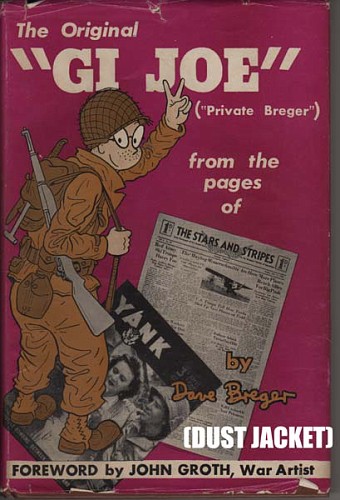
Private Breger was also seen on post cards. The character remained a private throughout WWII while Breger himself was promoted through the ranks to corporal, sergeant and eventually lieutenant. Returning to civilian life after WWII, Breger became a founding member of the National Cartoonists Society in 1946, and Private Breger was altered to become Mister Breger, a gag panel for King Features. Breger and his wife Dorathy settled in West Nyack, New York where they had three children — Dee, Lois and Harry.
Mister Breger continued to run daily until 1969. In one cartoon, Breger predicted that since television showed so many old movies, the day would come when movie theaters would turn to vintage television for product. This prediction came true with the advent of such TV-based films as Mission: Impossible and Star Trek.
His 1955 book, But That’s Unprintable!, provided an inside look at the taboos faced by cartoonists who contributed to newspaper syndicates and magazines. When Breger died in 1970, he was cremated at Ferncliff Cemetery in Hartsdale, New York.
Hasbro’s G.I. Joe is a different character, trademarked as "G.I. Joe, A Real American Hero."
Sgt.George Baker:
Sad Sack:
The Sad Sack originated as a comic strip, drawn in pantomime, which debuted in June 1942 in the first issue of Yank, the Army Weekly. It proved popular, and a hardcover collection of Baker’s wartime Sad Sack strips was published by Simon & Schuster, Inc. in 1944, with a follow-up volume, The New Sad Sack, in 1946. The original book was concurrently published as an Armed Services edition mass market paperback, in that edition’s standard squarebound, horizontal, 5 5/8 x 4-inch format, by Editions for the Armed Services, Inc., a non-profit organization of The Council on Books in Wartime; it was #719 in the series of Armed Service editions.
After the war ended, The Sad Sack ran in newspaper syndication until 1960. Supporting characters included “The Sarge” (Sack’s platoon sergeant, the potbellied and tough but reasonable Sergeant Circle); “Slob Slobinski” (Sack’s buddy); “The General” (General Rockjaw, always drawn with dark glasses, cigarette holder and Ascot tie) “Sadie Sack” (Sad’s redheaded female cousin, in the WACs), “Ol’ Sod Sack,” Sad’s hillbilly uncle, and “Muttsy” the dog. The spin-off Sad Sack Navy, Gobs ‘n’ Gals had the supporting character “Gabby Gob”.
The Harvey Comics and newspaper strip were aimed at younger readers than Baker’s wartime originals, and the style of the strip changed dramatically. In the newspaper strip, the pantomime style was abandoned in favor of a more conventional comic-story format.
In the mid-1950s, Harvey Comics and Baker brought in Paul McCarthy to draw the Sad Sack titles, followed by Fred Rhoads, Jack O’Brien and Joe Dennett. Others who periodically drew for the titles include Warren Kremer and Ken Selig. Baker retained editorial control and continued to illustrate the covers of Sad Sack comics until his death in 1975.
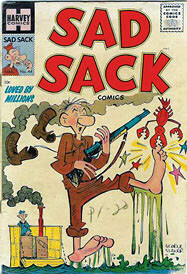
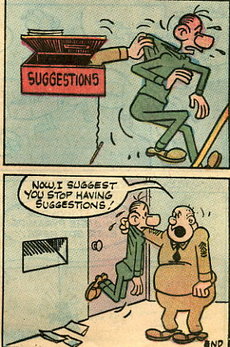
Elzie Crisler Segar:
Popeye
Popeye the Sailor is a fictional hero famous for appearing in comic strips and animated films as well as numerous TV shows. He was created by Elzie Crisler Segar,[1] and first appeared in the daily King Features comic strip Thimble Theatre on January 17, 1929.
Although Segar’s Thimble Theatre strip, first December 19, 1919, was in its tenth year when Popeye made his debut, the sailor quickly became the main focus of the strip and Thimble Theatre became one of King Features’ most popular strips during the 1930s. Thimble Theatre was carried on after Segar’s death in 1938 by several writers and artists, including Segar’s assistant Bud Sagendorf. The strip, now titled Popeye, continues to appear in first-run installments in Sunday papers, written and drawn by Hy Eisman. The daily strips are reprints of old Sagendorf stories.
In 1933, Max and Dave Fleischer’s Fleischer Studios adapted the Thimble Theatre characters into a series of Popeye the Sailor theatrical cartoon shorts for Paramount Pictures. These cartoons proved to be among the most popular of the 1930s, and the Fleischers—and later Paramount’s own Famous Studios—continued production through 1957.
Since then, Popeye has appeared in comic books, television cartoons, arcade and video games, hundreds of advertisements and peripheral products, and including a 1980 live-action film directed by Robert Altman starring comedian Robin Williams as Popeye.
continued........................
-
01-22-09, 06:19 AM #2

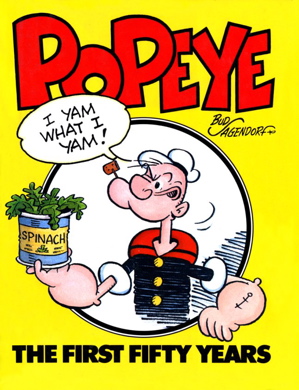
Mort Walker:
Beetle Bailey
In 1948 and 1949, Mort Walker submitted his comics to magazines such as the Saturday Evening Post. The Post’s editor, John Bailey, suggested he draw some comics in a university setting, having seen some of Mort Walker’s work during university. Walker did so, and Bailey suggested that he feature one character, who wore a hat down over his eyes. Walker named him Spider, after a fraternity brother.
Walker then decided to create a comic strip about a university, putting all of his fraternity brothers from the University of Missouri in it. Changing the name from Spider to Beetle, King Features Syndicate bought it; it was the last comic strip personally approved by William Randolph Hearst. Bailey was added as a family name in honor of John Bailey. Beetle Bailey first ran in twelve newspapers on September 4, 1950, the day after Mort Walker’s birthday.
On March 13, 1951, during the Korean War, Walker had Beetle Bailey enlist in the Army. At the time, Beetle was dating two girls at his university at the same time, each did not know about the other. One day, he saw them walking down the street separately to the corner where he was. They didn’t see him or each other. Right in front of him was the U.S. Army Enlistment Office and Beetle ducked in and enlisted to avoid being seen by them. All characters other than Beetle were dropped, and new ones created. The struggling comic strip (King Features was considering not renewing the one-year contract) soon appeared in more newspapers, beginning Beetle’s rise to popularity.
Walker received the Reuben Award for 1953, as well as the National Cartoonist Society Humor Strip Award for 1966 and 1969 for the strip. King Features Syndicate is the distributor. A TV version was made in 1963.
Most of the humor revolves around the mostly inept characters stationed at Camp Swampy, inspired by Camp Crowder, where Walker had been stationed while in the Army. Private Bailey is a lazy sort who usually naps and avoids work, and thus is often the subject of verbal and physical chastising from his Sergeant.
The comic strip currently takes place in present day. The characters in Beetle Bailey have never seen combat themselves, with the exception of mock battles and combat drills. In fact, they seem to be in their own version of stereotypical comic strip purgatory (initially basic training, they now appear to be stuck in time in a regular infantry division). The uniforms of Beetle Bailey are still the uniforms of the 1950s Army, with green fatigues and baseball caps as the basic uniform, and the open jeep as the basic military vehicle. Sgt. Snorkel wears a green dress uniform with heavily wrinkled garrison cap; the officers wear M1 helmet liners painted with their insignia. While Beetle’s unit is “Company A”, one running gag is that the Beetle Bailey characters are variously seen in different branches of the Army, such as artillery, armor, infantry, paratroops, etc.
Beetle’s sister is Lois Flagston of the comic strip Hi and Lois, a spinoff that debuted in 1954.
Beetle is always seen with a hat or helmet over his head, forehead, and eyes. He was only seen without it once in the original strip when he was still in college; the strip never ran in any newspaper and is only seen in various books on the history of the strip. In a Mad Magazine parody in the April 1969 issue, Beetle’s hat is removed and on his forehead is written “Get out of Vietnam”. One daily comic strip had Sarge scaring Beetle’s hat off, but Beetle was wearing sunglasses.
A running gag in the strip is of Sgt. Snorkel hanging helplessly to a small tree after having fallen off a cliff. While he is never shown falling off, or even walking close to the edge of a cliff, he always seems to hold on to that tree, yelling out for help.
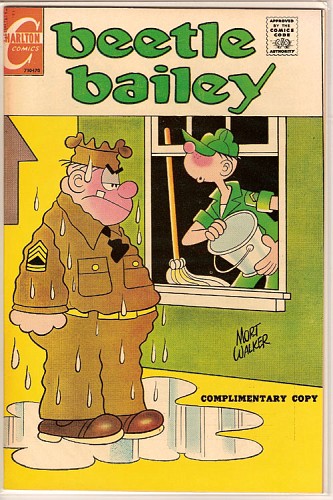
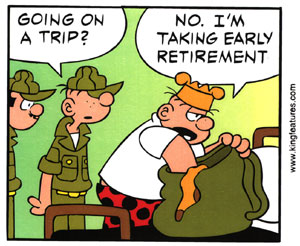
Ellie
-
01-22-09, 06:24 AM #3
"Just give me the aspirin. I already got a Purple Heart."
Bill Mauldin, Stars and Stripes (1944)

"... forever, Amen. Hit the dirt."

The Prince and the Pauper
-
01-22-09, 06:30 AM #4

"You're right. Th' town has been occupied three days."

Thread Information
Users Browsing this Thread
There are currently 1 users browsing this thread. (0 members and 1 guests)



 Quote
Quote
Ghost Of Iwo Jima
04-04-24, 11:35 PM in Open Squad Bay